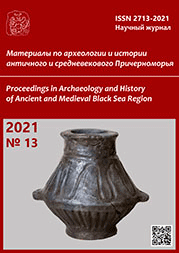Саркофагообразный надмогильный памятник с куфической надписью мусульманского некрополя Дербента XI—XII вв.
Sarcophagous tombstone with Kufic inscription of the Derbent muslim necropolis of the 11th — 12th cc.
Author(s): Murtazali Gadjiev, M.A. GasanovSubject(s): History, Archaeology, Cultural history, 6th to 12th Centuries, History of Islam
Published by: Нижневартовский государственный университет
Keywords: Caucasus; Derbent; Bab al-abwab; Muslim cemetery; tombstone; epitaph; Arabic epigraphy; Kufic writing;
Summary/Abstract: In 2020 during secure and rescue archaeological observations in Derbent, the Muslim burial ground, representing once vast separate section of medieval urban necropolis of Derbent outside the architecturally allocated shahristan, was identified. This site has more than 80 sarcophagus-shaped tombstones, which are conventionally referred to by their shape as “sarcophaguses” and dated to the last third of the 11th — 12th centuries. Among them there is a single sarcophagus, on the southern longitudinal side of which there is an inset inscription — epitaph, written in Arabic in Kufi handwriting. Its text reads: “This is the grave of Muhammad, the tinsmith. May Allah have mercy on him!”.The monument is a rare example of sarcophagus-shaped tombstones with inscription. According to the epitaph, the buried man was a tinker and this information expands the range of craft specialties that existed in Derbent in the 11th — 12th centuries, and indicates the specialization of handicraft work in the processing of non-ferrous metals, taking into account the existence of manufacturers of copper objects, coppersmiths in Derbent. At the same time, the text of the epitaph shows not only the profession, but also the nickname of the buried man — Muhammad Lahim “Muhammad Tinsmith”. It’s possible that this sarcophagus was installed over the burial of one of the respected representative of the Sufi community in Derbent of the last third of the 11th — 12th centuries.
Journal: Материалы по археологии и истории античного и средневекового Причерноморья
- Issue Year: 2021
- Issue No: 13
- Page Range: 942-953
- Page Count: 12
- Language: Russian

